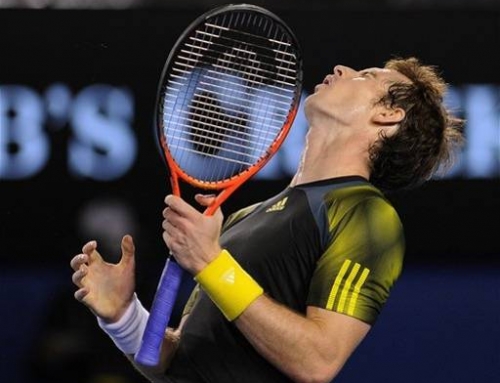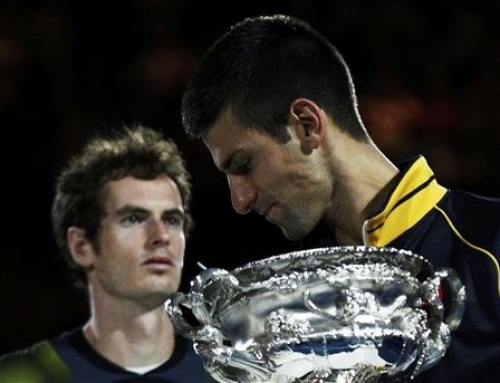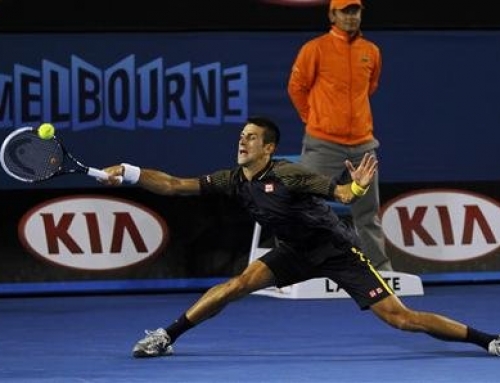 Everyone loves to do it, but it really doesn’t make sense. Back in December, people were asked “make predictions who will win the Slams in 2011”. You never know which player will come out of nowhere to make an impression. If you were to ask, at the end of 2008, who would win the Slams in 2009, no one would have said Nadal would fail to win the French, or del Potro would win the US Open. Many of these predictions depend on the health of the players. For Nadal, it can be his legs. For Djokovic, it’s dealing with the heat. Even Murray has been ill at Slams and not gone as deep as he had hoped. Roger blamed back and leg issues from playing his best in 2010.
Everyone loves to do it, but it really doesn’t make sense. Back in December, people were asked “make predictions who will win the Slams in 2011”. You never know which player will come out of nowhere to make an impression. If you were to ask, at the end of 2008, who would win the Slams in 2009, no one would have said Nadal would fail to win the French, or del Potro would win the US Open. Many of these predictions depend on the health of the players. For Nadal, it can be his legs. For Djokovic, it’s dealing with the heat. Even Murray has been ill at Slams and not gone as deep as he had hoped. Roger blamed back and leg issues from playing his best in 2010.
During the post-match interview, Nadal said he tried his best to prepare for 2011, but he didn’t know he’d get sick in Doha. He didn’t know that he’d tweak a hamstring and be unable to move as well as he normally does. Ferrer still had to hold up his end of the bargain. A wounded Nadal doesn’t always lose. Few knew Nadal tweaked his abs in the 2009 US Open (and before). He still managed to beat Monfils. But he got thumped by del Potro. Would a healthier Nadal lost so lopsidedly? Probably not.
Ferrer’s strategy was to attack the Nadal backhand, and then open up the forehand. He also played many more balls up the middle to take away angles from Nadal. Nadal can be deadly with angles and so playing shots up the middle usually elicits a neutral reply back down the middle. Ferrer was also trying to hit a bit harder than usual, and that lead to more errors than Ferrer usually makes. But with Nadal unable to track down the balls he usually reaches, Ferrer would get break after break until Nadal would eventually make a few holds.
This was an unexpected loss. Ferrer can struggle with Nadal’s power. If Nadal gets you on the defensive, he can take over a point, even for a guy as quick as Ferrer. But who expected Nadal to be injured.
Much like last year’s match against Murray, this match was interrupted by fireworks on Australia Day. Not that it would have mattered much, but the break probably wasn’t helpful to Nadal who didn’t need the cooldown.
One of those matches that’s hard to predict.
In the other quarterfinals, Murray took on Dolgopolov. For a while, Dolgopolov looked amazing. Murray’s learned to hit the crosscourt forehand with huge pace, but Dolgopolov is amazing hitting down the line off that shot and did that on the forehand side and the backhand side. Only Murray’s quickness allowed him to chase down a few of those shots and hit squash shots and slices to keep in points.
Eventually, Murray made a few adjustments. He used the slice backhand far more than he normally does. He also took away some of the angle Dolgopolov feeds on. Dolgopolov began to overhit and make errors, and that would let Murray into the match.
Dolgopolov hits some of the hardest hit slices I’ve seen. It doesn’t seem to move through the air differently, but you can see the chop movement. He also gave Murray a few problems by hitting the short crosscourt slice just inside the service line forcing Murray to approach. Dolgo also delighted in dropping Murray giving Murray some of the same medicine he dishes out to others.
Murray showed the slice is still a great counterpunching weapon. When Dolgo was punishing the ball, often the slice forehand and backhand kept Murray in points and even won a few. Murray hit a few slice lobs that just cleared Dolgo’s reach. It’s rare that Murray needs this kind of variety to win matches, but he always has it in his back pocket. Every top pro has learned how to hit these slices against good players.
Honestly, if Dolgo wasn’t so error-prone, he could easily be a top ten player. He still looks like he’ll head in that direction. Of the names that get mentioned for newcomer in tennis, Dolgopolov is currently the most mature and that’s partly reflected in his rankings. He’s got better control of his power, has at least as much variety as Tomic, and where Tomic’s slice looks floaty, almost attackable, Dolgo’s slice looks vicious.
So, the semifinals is three-quarters what experts (who needs to be an expert when you predict the “top 4” seeds–I know, Murray is seeded 5th, but he’s been a top 4 for a long time that I call him a top 4). Few expected Nadal, of the top players, would not be there. Many would have guessed Murray or Djokovic.
Murray actually has a losing record to Ferrer, but all Ferrer’s win have been on clay (3 wins) while Murray has won 2 hardcourt encounters (including the round robin in last year’s year-end event). Murray should be favored over Ferrer, but he’ll need to be on top of his game. Murray can even give some credit to Ferrer for serving as bellwether to his game. Ferrer beat him twice on clay right before the French when Murray was trying to move from indifferent play, a result of moping for a few months, to the kind of play he used to reach the Wimbledon semis. Certainly, Murray’s chances of winning the Aussie Open are much improved over playing a healthy Nadal.
On the other side, Djokovic is probably playing more solid tennis than Federer, but Fed did beat Djokovic all but once last year. Djokovic will feel he has something to prove. Federer, meanwhile, wants to keep pushing to win more Slams while he can. Since he is defending champ, he will lose points if he doesn’t win again. Meanwhile, Nadal lost in the quarters last year as well, so his point total won’t change.
I expect this to be the match to watch. Both will like the idea that they get a day of rest in case they play a long match like they did at the US Open.
Meanwhile, the Rafa Slam which seemed so plausible, so likely is lost again to history. Roger Federer must be relieved as well, though he has the tougher of the two semifinals. And now Rafa gets to reflect on his career once again. Filled with such highs and such lows. As Murray tweeted, when you can meet with triumph and disaster and treat these impostors just the same (or the tweet-ified version of such), you will be a man, my son. And Nadal tries to be his same humble self when he deals with both, as painful as that can be in defeat.






![[Aussie Open Final] Can Andy Murray beat Novak Djokovic?](https://www.essentialtennis.com/wp-content/uploads/2013/01/20130126andy-500x383.jpg)
![[Day 13, Aussie Open] Bryan brothers win 13th Slam with Aussie doubles title, Kyrgios wins boys title](https://www.essentialtennis.com/wp-content/uploads/2013/01/20130125bryan-500x383.jpg)